
Книги 2021 – 2022
Selected bibliography in the field of Bulgarian Studies published in the current year
More...We kindly inform you that, as long as the subject affiliation of our 300.000+ articles is in progress, you might get unsufficient or no results on your third level or second level search. In this case, please broaden your search criteria.

Selected bibliography in the field of Bulgarian Studies published in the current year
More...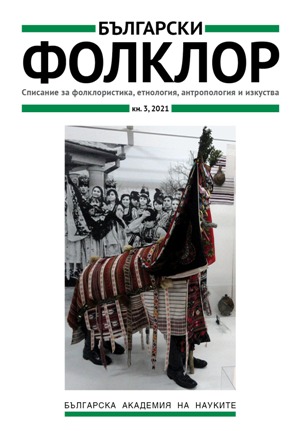
This contribution explores the music performance during the reading of a barely known and insufficiently studied life of the Prophet Muhammad, İpsala'lı Ebu'l-Hayr Mevlidi, better known as Mustafa Mevlidi. That life is used in the Mevlid rituals in the region of Krumovgrad and in some villages near the town of Haskovo. In order to present in fullness the specific local characteristics of the music connected to religious practice in the studied region, the author describes in detail the peculiarities of the music in the cami practice. The main characteristics of the ritual are delineated: its structure, the occasions on which it takes place, and the way of performing it. In the course of analysis of the musical material, which has been recorded in the region of Krumovgrad, the author also adds musical examples from the Mevlid ritual among Sunni Turks from other parts of Bulgaria. The main fieldwork material utilized in the study has been personally collected by the author between 2010 and 2021.
More...
For almost three decades now, there is an ongoing, but also inconsistent search for a new conceptual framework for the study of ethnicities and identities. Against this background, the article offers an interpretation of a fundamental monographic text on this subject from the recent past, a contemporary evaluation of a book from the arsenal of ethnic/national dialectic theory. Written by an insightful connoisseur of culture and history, the book presented some innovative and provocative ideas about the relationship and the dynamic combination of the most important phenomena and characteristics of the ethnonational process. The author shares some thoughts about the ways in which these ideas can be interpreted from the point of view of today’s methodological explorations.
More...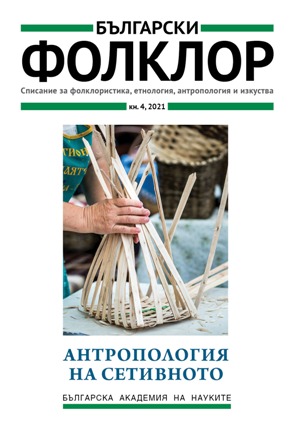
Paradoxically enough, our present times combine conservation with the destruction of architectural heritage. The preservation of this heritage is closely related to the foundation of the nation state and serves to show the “national genius” embodied by the peasant. Simultaneously, the different disciplines that study the issues of architectural heritage show that there is a tendency of mutual disregard. Nevertheless, the transnational concept of the rural home in Southeast Europe (mainly Romania and former Yugoslavia) which I have studied and documented in the 1970-s, displays similar features in close geographical zones, and also in zones that are marked by the culture and history of imperial colonization: Austrian in the first case and Ottoman in the second. The perspective from the point of view of regional heritage makes possible to apply a trans-border approach in order to reveal connections of kinship between neighboring villages separated by political boundaries. In the article, the differences between certain cultural areas are explained with the support of history.
More...
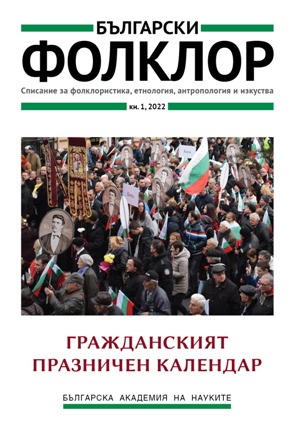
The paper puts forward the proposition that today’s Bulgarian civic festive calendar may be examined as a system composed not of individual holidays but of corresponding holiday pairs (3 March – 2 June, St. George’s Day – St. Michael the Archangel’s All Soul’s Day, 24 May – 1 November). The holiday pairs have been formed gradually, and in the course of time a ‘strong’ and a ‘weak’ holiday came to exist, the former – honouring a supreme community value, whereas the latter – paying respect to the memory of the heroes who devoted their lives to its achievement. The paper makes an attempt to substantiate the thesis that dualism is the leading trend in the development of the festive calendar, which might be observed in its past historical stages as well.
More...
The article examines and analyses the process of “inventing” Kyustendil Spring Day in the context of socialist festivity. Based on the local tradition of welcoming spring in Kyustendil, which integrates pre-Christian rituals related to the day of spring solstice, the Day of Forty Martyrs of Sebaste in the Orthodox calendar and Mladentsi in the folk calendar, the holiday is gradually “domesticated” by the socialist authorities in the late 1960s, purged of its religious elements and re-invented – engaged with “new, socialist content”. Having combined various festive forms, symbols and rituals and occupying various urban spaces throughout the years, the holiday eventually established itself as a successful “invented tradition” during the socialist period, including several elements: a beauty contest, a ceremony for handing over the symbols of spring, a carnival procession, a public celebration on the Hisarlaka hill above the town, and accompanying cultural and sports events.
More...
The holiday is an essential element in the ideological regulation of public life; it plays an important role in shaping and stabilizing the group celebrating it, in all cases by actualizing the most important unifying values, and very often – by distinguishing examples of exemplary behaviour. The spread of the COVID-19 epidemic at the very beginning of 2020 leads to a number of radical changes in social life. The speed with which processes develop, as well as the search for new forms to continue established practices, leads to experimentation with the possibilities of new technologies, as well as of new conditions – education in an online environment, online shopping, outsourced commercial cash registers for outdoor service, limiting the capacity for public access, reducing programs, etc. Limiting physical access to official celebrations provoked an attempt to compensate for it by broadcasting the festive ceremonies live. However, the transfer of an event to an online environment places local communities in the passive role of spectators of a performance, without the opportunity of participation, and the social function of the celebration is reduced to the possibilities of the social network to communicate through texts and chat with other representatives of the community who observe the broadcast. These restrictions seem to compromise the very idea of a celebration and make visible the fact that its fundamental feature is the possibility of physical presence and participation of citizens.
More...
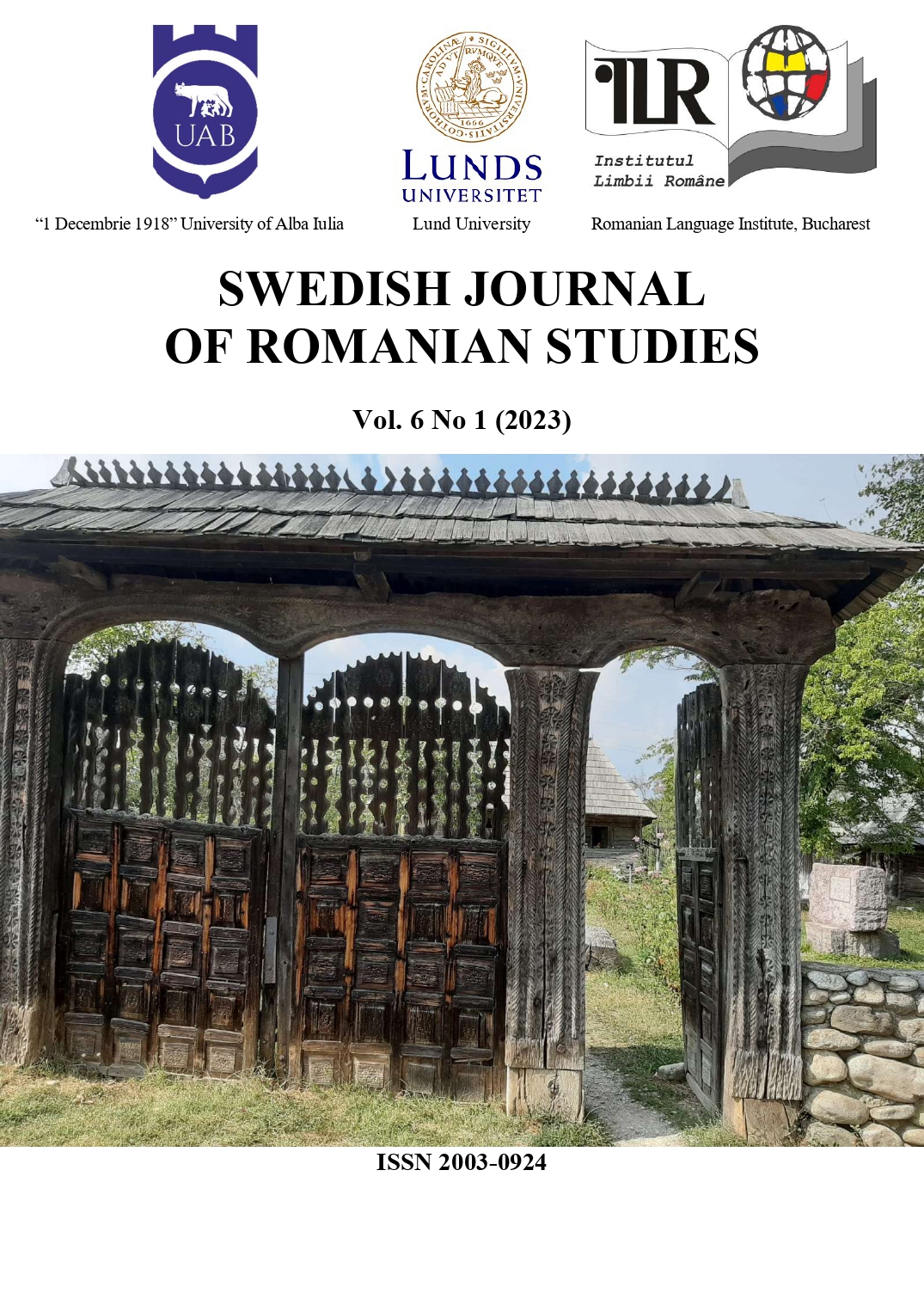
The knowledge existent at present, which generates the need for a new approach to the myth of Dracula, refers to an almost unanimous reception based on the novel published in 1897 by Bram Stoker and on the tens of the subsequent portrayals which have induced a social and cultural paradigm standardized as commercial kitsch. Within this fictitious construct Dracula has been expounded in manifold keys. However, to ordinary perception, his figure is reduced to the semi-caricatural vampire character, the living-dead craving for blood. This article aims to answer a series of questions about the representations of Dracula and their relevance to the fields of cultural and literary studies: Which is the “real” Dracula? Which are the psychological, cultural, social and historical impulses determining the actions of the character and the established myth? To what extent the deeds of the personage can be accounted for through the instrumentality of psychological impetus and by the agency of cultural, philosophical, esoteric, and occult principles? Thus can the “real” Dracula be integrated into an ampler context of culture and civilization, where his alienation and his monstrosity belong less to the paradigm of “the other”, of “the stranger” and refer more to the revealing of some of “our” intimately repressed human features?The article proposes a critical examination and reinterpretation of Dracula’s image, starting from the novel Jurnalul lui Dracula (Dracula’s Diary) (1992) by the Romanian writer and academic Marin Mincu. Original responses are being suggested to the questions defined previously – through several writing and literary theory techniques, including references to Corpus Hermeticum.By comparing and contrasting the hermetic philosophical text and the Romanian novel, the essay aims at finding out whether the entire construct of the myth of Dracula can be explained through two cultural and philosophical aspects, namely death and immortality. It also offers a new reading, another conceptualization of a familiar but debatable subject, which reinterprets and even rejects the mainstream view. The work by the extremely well-informed Romanian academic, which was first published in Italy, has nothing in common with Bram Stoker’s (“vampiric falsification”, asserts the author in the preface…), but vividly portrays the “real” Dracula, the Prince Vlad the Impaler, imprisoned in the underground cave of a castle under the Budapest Danube, writing a journal between February, 2nd, 1463 and August, 28th, 1464. In his diary the character recalls his historical fate and legendary destiny through references to aspects of Romanian culture and civilization considered in a European context. For instance, the study approaches topics such as: the religion of Zalmoxis as the philosophical and existential foundation of the Romanians; Dacians’ attitude towards death, as described by Herodotus, which might have influenced Pythagoras, Socrates, the Eleusinian and the Orphic Mysteries; the boycott of history by the Romanian people (an echo from philosopher Lucian Blaga’s writings); the orality of the Romanian culture (as opposed to the written culture of the western Europe); the oral folkloric creations, the ballad Miorița (The Little Ewe) and the fairy-tale Tinerețe fără bătrânețe și viață fără de moarte (Youth without old age and life without death), etc. All of these are put forward within the humanistic, Renaissance context of the epoch, given that Dracula was a friend of Marsilio Ficino, Nicolaus Cusanus, Pope Pius II, Cosimo de’ Medici, etc. Researchers will discover new speculative themes and directions with regard to the seemingly exhausted myth of Dracula.
More...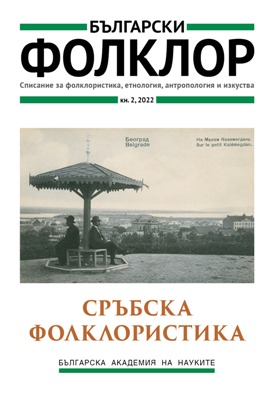
This paper analyses the attitude of Bulgarian researchers towards the phenomenon of bugarštica, with special reference to the book “Croatian Bugarštica Songs and Their Bulgarian Counterparts. Studies and Texts”, edited by Stefana Stoykova and published in 2015 by the Bulgarian Academy of Sciences and the Institute of Ethnology and Folklore Studies with Ethnographic Museum. Stefana Stoykova substantiates the thesis about the Bulgarian origin of the bugarštica, present in the research spanning from Ivan Shishmanov to Antonina Afanasieva-Koleva, by analysing Bulgarian recordings from the 20th century in which, according to Stoykova, traces of bugarštica singing still remain preserved. By analysing the formula “orao se vijaše” [an eagle hovered] and the conceptualization of the falcon figure (in metaphors, as a mythical mediator between the worlds, etc.) in oral lyrical poetry in South Slavic context, this paper uncovers the consonance between bugarštica singing and other genre patterns from the 15th until the 20th century primarily in shared formulas, in style and language, in archaic mythological symbolism. The commonness of these elements is attributed to cohabitation, frequent migrations and the broadest processes of creation and duration in oral epic and lyrical traditions in South Slavic cultures.
More...
This paper explores the position of the rebellious, disobedient hero in his own environment on the examples of South Slavic and Russian epics; more precisely, it explores the hero’s disobedience to an authority from his social or family domain. There is a collision between the heroic status of the hero, emphasizing disobedience, independence and pride, with his social and family status, which lowers the hero on the hierarchical ladder. The hero opposes the will of his superior and sometimes explicitly shows his defiance through special gestures, specific gait or riding, often in the same way as his enemy, but unlike the enemy’s, his arrogance and daring are not always punished. An insubordinate hero is not a frequent type, although often a young hero and a neophyte. Besides, disobedience is not reserved for one and the same characters, although the most disobedient heroes are the greatest Russian hero Ilja Muromec and the greatest South Slavic hero Marko Kraljević. Disobedience is only partially a means of the heroes’ characterization, it is mainly used as a motivation, as an element of the commencement that, through the initial collision, opens the possibility for different variants of the plot, in which, in most poems, the epic prevails over the balladic resolution, the heroism over the punishment for hybris, the heroic over the magical principle.
More...
Phenomena defined in contemporary folkloristics as postfolklore, small groups folklore, urban folklore have for long been out of the focus of Serbian folkloristics, and papers on this topic have only recently started appearing. Quite understandably, the studies are directed towards contemporary material. However, the diachronic aspect of these phenomena exists too. The testimonies of the existence of such forms of folklore in the past can be found in memoir and diary literature, as well as in the corpus of historical (not folkloristic) archives. All these past phenomena are covered here with the umbrella term “other folklore” whose function is descriptive, not theoretical. Everything that folkloristic paradigms in the past failed to see as a “real” folklore (equated with oral, rural, and traditional) – making that material invisible and hidden in the sources less used by folklorists – is classified here as “other.” “Other folklore” in this case encompasses a few kinds of folklore: folklore of small groups (criminals and prisoners, students, seminarists) and urban folklore (mostly connected to Belgrade). Political folklore could belong here too. It is often close to traditional genres in its forms, but historical and political conditions have made it unsuitable and evicted it to the out-of-sight memory of memoirs and diaries (such are, say, monarchist songs from World War II, or political jokes from the time of Communism). Political folklore sometimes coincides with other “otherness” categories, say, the parodic urban folklore from the time of the Nazi occupation of Belgrade that is an example both of political and urban creativity; humoristic and unheroic, it did not fit the folklore of resistance ideal even upon the end of the war. Such a corpus approach makes it possible to see the diachronic background of many contemporary examples and discover new sources of folklore in the less examined material. More importantly, the definitions of folklore themselves are tested by this approach (surely, along the lines of Popper’s criticism of “facts,” it is definitely not a “discovery,” but a re-evaluation of concepts before approaching the corpus). Finally, such analyses can be useful to historians too, because they reveal the hidden side of certain epochs and their mind-sets, as well as the genre conditionality of historical sources.
More...
The Ethnographic Collection, today a part of SASA Archives, was initiated by Stojan Novaković in order to continue Vuk Karadžić’s work on collecting folklore. The goal of the Academy was to get the material collected, systematized and published, and the task of collecting was entrusted to individuals, such as teachers and priests, who lived among the people and were literate enough to record various forms of folklore. The questionnaires they used were intended for ethnographic and anthropogeographic research, which means that there were no clear instructions for recording folk tales. In this paper, I use the term textualization (after Lauri Honko), defined here as secondary, because it refers to the representation of the written (rather than spontaneous oral) text, in order to point out different models/strategies of recording folk tales used by collectors in the last decades of the 19th and first decades of the 20th century. Depending on their position, recording of the folklore material was sometimes influenced by ethnography or dialectology, considering that the mentioned disciplines were on their rise, while the literary model appears as a regional distinction.
More...
Book Review: Савремена српска фолклористика VIII ‒ словенски фолклор и књижевна фантастика. Ур. Дејан Ајдачић и Бошко Сувајџић. Београд: Удружење фолклориста Србије, Универзитетска библи- отека „Светозар Марковић”; Кијев: Комисија за фолклористику Међународног комитета слависта; Лозница: Центар за културу „Вук Караџић”, 2020. 518 стр. ISBN 978-86-7301-149-3
More...
Book Review: Ана Вукмановић. У трагању за извир водом. Слике воде у јужнословенској усменој лирици. Београд: Академска књига, 2020. 296 стр. ISBN 978-86-6263-301-9
More...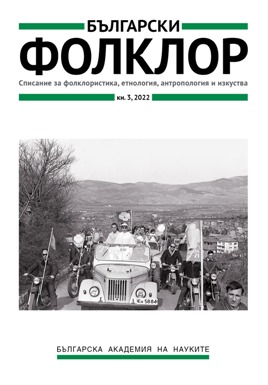
This article aims to outline the main sociocultural aspects of menstruation in Bulgarian traditional culture and folklore. Menarche rituals and etiological legends about the womb’s creation and the menstruation are explored and analyzed in order to define folklore motifs and beliefs. The woman and her cyclicity is related to fertility in the human world. Both in legends and in menarche rituals, the womb and the menstruation are essential for arranging and preserving the dimension between order and chaos, for building a connection between heaven and earth. The magical power of woman's blood and body is included in the cultural system of the human world, but it also aims to achieve prosperity on other levels. This sacred and mysterious physiological process gives woman a special place, makes her wiser and more responsible for the common good.
More...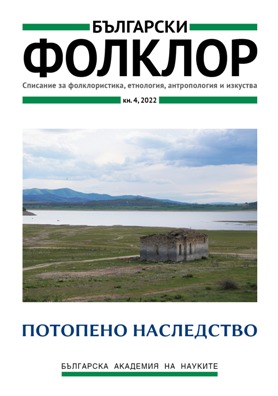
I explore the connections between a particular place that was created by a natural agent (the Yantra River) and an artificial object (the ‘buna’), and the activities by which local people gave the place a specific character. I highlight their past actions and experiences; remembering, recounting and evaluations in the present; the emotional attachment to the place and the ecological nostalgia after its ‘loss’ due to hydro technical intervention.
More...